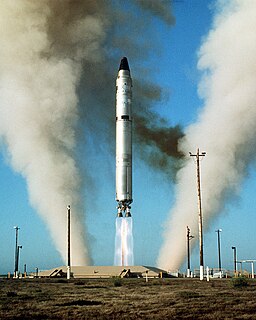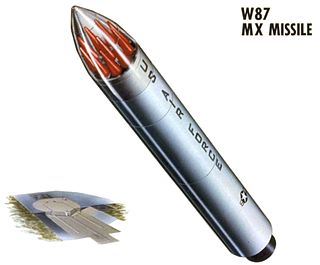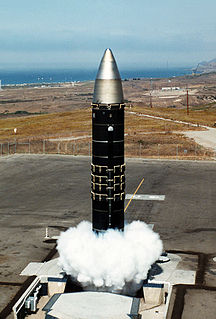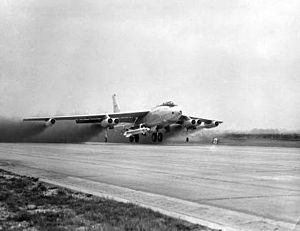
An intercontinental ballistic missile (ICBM) is a missile with a minimum range of 5,000 kilometres (3,100 mi) primarily designed for nuclear weapons delivery. Similarly, conventional, chemical, and biological weapons can also be delivered with varying effectiveness, but have never been deployed on ICBMs. Most modern designs support multiple independently targetable reentry vehicles (MIRVs), allowing a single missile to carry several warheads, each of which can strike a different target. Russia, the United States, China, France, India, the United Kingdom, and North Korea are the only countries that have operational ICBMs.

The UGM-27 Polaris missile was a two-stage solid-fueled nuclear-armed submarine-launched ballistic missile (SLBM). As the United States Navy's first SLBM, it served from 1961 to 1980.

The Douglas GAM-87 Skybolt was an air-launched ballistic missile (ALBM) developed by the United States during the late 1950s. The basic concept was to allow US strategic bombers to launch their weapons from well outside the range of Soviet defenses, as much as 1,000 miles (1,600 km) from their targets. To do this in an air-launched form, a lightweight thermonuclear warhead was needed. Initially, the W47 from the Polaris missile was selected, but it was later replaced by the W59 from the Minuteman missile.

A ballistic missile follows a ballistic trajectory to deliver one or more warheads on a predetermined target. These weapons are guided only during relatively brief periods—most of the flight is unpowered. Short-range ballistic missiles stay within the Earth's atmosphere, while intercontinental ballistic missiles (ICBMs) are launched on a sub-orbital trajectory.

The LGM-30 Minuteman is an American land-based intercontinental ballistic missile (ICBM) in service with the Air Force Global Strike Command. As of 2021, the LGM-30G Minuteman III version is the only land-based ICBM in service in the United States and represents the land leg of the U.S. nuclear triad, along with the Trident submarine-launched ballistic missile (SLBM) and nuclear weapons carried by long-range strategic bombers.

A multiple independently targetable reentry vehicle (MIRV) is an exoatmospheric ballistic missile payload containing several warheads, each capable of being aimed to hit a different target. The concept is almost invariably associated with intercontinental ballistic missiles carrying thermonuclear warheads, even if not strictly being limited to them. By contrast, a unitary warhead is a single warhead on a single missile. An intermediate case is the multiple reentry vehicle (MRV) missile which carries several warheads which are dispersed but not individually aimed. Only the United States, the United Kingdom, France, Russia and China are currently confirmed to possess functional MIRV missile systems. Pakistan and India are developing MIRV missile systems. Israel is suspected to possess or be in the process of developing MIRVs.

Chevaline was a system to improve the penetrability of the warheads used by the British Polaris nuclear weapons system. Devised as an answer to the improved Soviet anti-ballistic missile defences around Moscow, the system increased the probability that at least one warhead would penetrate Moscow's anti-ballistic missile (ABM) defences, something which the Royal Navy's earlier UGM-27 Polaris re-entry vehicles (RV)s were thought to be unlikely to do.

The LGM-118 Peacekeeper, originally known as the MX for "Missile, Experimental", was a MIRV-capable intercontinental ballistic missile (ICBM) produced and deployed by the United States from 1985 to 2005. The missile could carry up to 12 Mk.21 reentry vehicles, although treaty-limited to 10, each armed with a 300-kiloton W87 warhead. Initially, 100 MX ICBMs were planned to be built and deployed, but budgetary concerns eliminated the final procurement and only 50 entered service. Disarmament treaties signed after the Peacekeeper's development concluded in its eventual withdrawal from service in 2005.

The Nassau Agreement, concluded on 21 December 1962, was an agreement negotiated between President of the United States, John F. Kennedy, and Harold Macmillan, the Prime Minister of the United Kingdom, to end the Skybolt Crisis. A series of meetings between the two leaders over three days in the Bahamas followed Kennedy's announcement of his intention to cancel the Skybolt air-launched ballistic missile project. The US agreed to supply the UK with Polaris submarine-launched ballistic missiles for the UK Polaris programme.
Lockheed Martin Space is one of the four major business divisions of Lockheed Martin. It has its headquarters in Denver, Colorado, with additional sites in Sunnyvale, California; Santa Cruz, California; Huntsville, Alabama; and elsewhere in the United States and United Kingdom. The division currently employs about 16,000 people, and its most notable products are commercial and military satellites, space probes, missile defense systems, NASA's Orion spacecraft, and the Space Shuttle external tank.

The People's Liberation Army Rocket Force, formerly the Second Artillery Corps, is the strategic and tactical missile force of the People's Republic of China. The PLARF is the 4th branch of the People's Liberation Army (PLA) and controls China's arsenal of land-based ballistic missiles—both nuclear and conventional. The armed service branch was established on 1 July 1966 and made its first public appearance on 1 October 1984. The headquarters for operations is located at Qinghe, Beijing. The PLARF is under the direct command of the Chinese Communist Party's Central Military Commission (CMC).

Nuclear weapons delivery is the technology and systems used to place a nuclear weapon at the position of detonation, on or near its target. Several methods have been developed to carry out this task.

A nuclear triad is a three-pronged military force structure that consists of land-launched nuclear missiles, nuclear-missile-armed submarines, and strategic aircraft with nuclear bombs and missiles. Specifically, these components are land-based intercontinental ballistic missiles (ICBMs), submarine-launched ballistic missiles (SLBMs), and strategic bombers. The purpose of having this three-branched nuclear capability is to significantly reduce the possibility that an enemy could destroy all of a nation's nuclear forces in a first-strike attack. This, in turn, ensures a credible threat of a second strike, and thus increases a nation's nuclear deterrence.

An air-launched ballistic missile or ALBM is a ballistic missile launched from an aircraft. An ALBM allows the launch aircraft to stand off at long distances from its target, keeping it well outside the range of defensive weapons like anti-aircraft missiles and interceptor aircraft. Once launched, the missile is essentially immune to interception. This combination of features allowed a strategic bomber to present a credible deterrent second-strike option in an era when improving anti-aircraft defences appeared to be rendering conventional bombers obsolete.
The ZBGM-75 Advanced Intercontinental Ballistic Missile, also known as Weapons System 120A (WS-120A), was a program to develop an intercontinental ballistic missile (ICBM), proposed by the United States Air Force in the 1960s as a replacement for the LGM-30 Minuteman as the Air Force's standard ICBM. Funding was not allocated for the program and the project was cancelled in 1967.

The Bold Orion missile, also known as Weapons System 199B (WS-199B), was a prototype air-launched ballistic missile (ALBM) developed by Martin Aircraft during the 1950s. Developed in both one- and two-stage designs, the missile was moderately successful in testing, and helped pave the way for development of the GAM-87 Skybolt ALBM. In addition, the Bold Orion was used in early anti-satellite weapons testing, performing the first interception of a satellite by a missile.

The High Virgo, also known as Weapons System 199C (WS-199C), was a prototype air-launched ballistic missile (ALBM) jointly developed by Lockheed and the Convair division of General Dynamics during the late 1950s. The missile proved moderately successful and aided in the development of the later GAM-87 Skybolt ALBM. It was also used in early tests of anti-satellite weapons.

The Alpha Draco missile, also known as Weapons System 199D (WS-199D), was an experimental ballistic missile developed by McDonnell Aircraft in the late 1950s to investigate the aerodynamic physics of the boost-glide reentry trajectory. Three test flights were conducted in 1959, of which two were successful.

STRAT-X, or Strategic-Experimental, was a U.S. government-sponsored study conducted during 1966 and 1967 that comprehensively analyzed the potential future of the U.S. nuclear deterrent force. At the time, the Soviet Union was making significant strides in nuclear weapons delivery, and also constructing anti-ballistic missile defenses to protect strategic facilities. To address a potential technological gap between the two superpowers, U.S. Secretary of Defense Robert McNamara entrusted the classified STRAT-X study to the Institute for Defense Analyses, which compiled a twenty-volume report in nine months. The report looked into more than one hundred different weapons systems, ultimately resulting in the MGM-134 Midgetman and LGM-118 Peacekeeper intercontinental ballistic missiles, the Ohio-class submarines, and the Trident submarine-launched ballistic missiles, among others. Journalists have regarded STRAT-X as a major influence on the course of U.S. nuclear policy.

Boost-glide trajectories are a class of spacecraft guidance and reentry trajectories that extend the range of suborbital spaceplanes and reentry vehicles by employing aerodynamic lift in the high upper atmosphere. In most examples, boost-glide roughly doubles the range over the purely ballistic trajectory. In others, a series of skips allows range to be further extended, and leads to the alternate terms skip-glide and skip reentry.
















